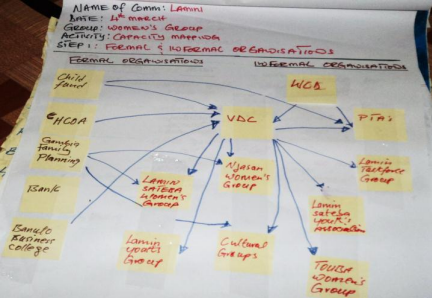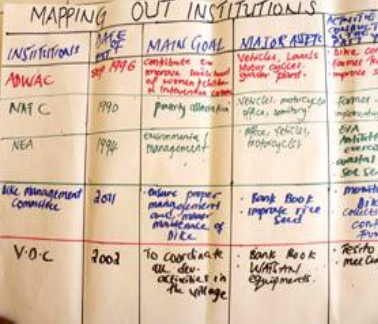Capacity and Asset Mapping

The following description of this tool and details on how and why it is was applied exists as part of the‘Adaptation Toolkit’ that was created collaboratively by SEI and ENDA.
With this tool, participants were trained on how to identify various capacities, skills and assets in a unit of analysis which could be built upon for future adaptation. This tool enhances a better understanding of available capacities skills and assets of a study area.
Brief Description
This exercise uses a potential-oriented approach in that, instead of focusing on the problems, gaps or issues affecting the site, it focuses on the capacities and positive potential that already exist. This approach is more likely going to create a positive mind-set and empower people for their own development ‘from the inside out’, rather than adopting a victim mentality and relying on intervention by government, international NGOs or others. In this exercise, stakeholders look to the past for where they did well before, narrating stories of success. Then they analyse the present to map assets. Facilitation is important as to build the right environment for people to feel encouraged to share stories about their skills, capacities and assets. This activity takes about an hour and a half.
Specific Objectives
The purpose of this exercise is to build a shared understanding of the existing capacities and assets in the site as a way to build on these capacities for future adaptation. Using a potential-oriented approach instead of a problem-oriented approach creates the positive environment for the stakeholders to be empowered and committed to the design and implementation of their adaptation and development strategies, and enables communities to be more strategic, considered and targeted about requesting or accepting assistance from others.
Expected Outcomes
- Better understanding of the capacities and skills that exist in the neighbourhood / community / project area
- Identification of assets that can serve as a basis to build adaptive capacity
- Better understanding of the formal and informal organisations in the local area, their collaborations and level of activity
Activities
Step 1: Successful Stories
In groups, ask participants to think about successful stories or events in the past and add them to a chronological line. Once they finish, facilitate a discussion around the following questions:
- What makes it a success story?
- For whom was it successful?
- Who contributed to it and how?
Step 2: Formal and informal organisations
- Using post-it notes, ask participants to identify the different associations/ organisations/institutions in the local area that play a role in the management of the resources identified in the first activity or/and in the decision-making or development planning activities at the project site. These should include both formal and informal entities (e.g. a registered orphanage, a study group and a savings club). On a flipchart, place the organisations according to how they interact with each other and show the linkages/ interactions with arrows. The ones that interact a lot should be placed close to each other on the page, and the organisations with fewer interactions should be placed more distant from each other.

Example of institutional mapping Lamin community- Gambia
Step 3: Asset mapping
- Once the organisations are placed, ask participants to record how long they have been in operation/active in the community or project site on the same post-it notes.
- Now create a table with 3 columns and record the full names organisations, their date of operation in the area, their goals and main assets. An example of this is represented in Figure 5. You can use the Sustainable Livelihoods Framework (see Box 1 for more information) as guidance to add assets under each capital (i.e. social, human, natural, physical and financial). In the description of assets, suggest participants to account also for intangible factors such as innovation and flexibility.
NB: As an optional activity, the researcher may further explore outside the group activities of the organisations conducted in the past year. This would help assess how active these organisations are and synergistic/conflicting missions.
Figure 5: An output of institutional mapping. Stakeholders’ workshop- Gambia
Resources/ Facilities
The facilities needed for this exercise are:
- Flipcharts
- Markers of different colours
- Post-it notes
- Notebooks to take notes of the discussions
Expected Output
The final products of this exercise are stories of success and maps drawn on flipcharts, as well as a synthesis of the discussions.
Footnotes
1. Prompting is needed to be done to ensure participants talk about intangible assets.

(0) Comments
There is no content